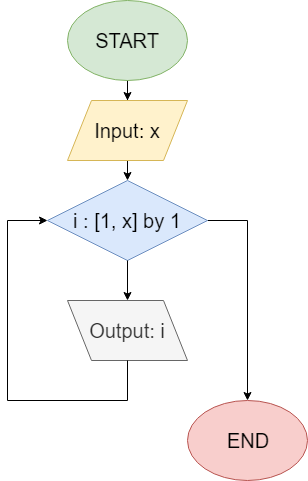For Loops
Most programming languages also support another type of looping construct, known as a For loop. A For loop usually includes an explicitly defined loop counter , a loop condition and loop counter incrementor as part of the loop definition, and is usually used to make sure that a loop only runs a set number of times. This is especially handy for instances where we need to accept exactly $ 5 $ inputs, or if the program should perform a calculation exactly $ 10 $ times.
Many programming languages support a variety of different ways to define how the loop counter in a For loop functions. For these examples, we’ll use a simple definition for the loop counter where it is just an integer that begins at one value and increments by $ 1 $ (the loop counter incrementor) each time until it reaches a second value (the loop condition).
Here’s a flowchart showing what a For loop may look like:
In this flowchart, we use the shorthand i : [1, x] by 1 to show that the loop counter i starts at the value
$ 1 $, and then each loop it is incremented by
$ 1 $ until it is larger than x. So, if x = 6, the loop counter i will have the values 1, 2, 3, 4, 5, and 6, and the loop will run exactly
$ 6 $ times.
When reading this aloud, we might say i : [1, x] as “For values of i from
$ 1 $ through x incrementing by
$ 1 $”. So, we could say this whole loop is “For values of i from
$ 1 $ through x incrementing by
$ 1 $, print i.” That should exactly match the original problem statement given earlier:
Write a program that accepts any positive integer as input, and then prints all integers starting with 1 up to the given number.
In code, there are many different ways that For loops are usually defined. We’ll learn how our programming language implements these loops later in this chapter.
